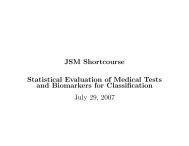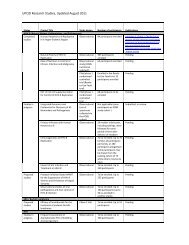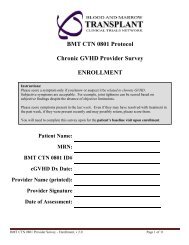Summer Undergraduate Research Program - Fred Hutchinson ...
Summer Undergraduate Research Program - Fred Hutchinson ...
Summer Undergraduate Research Program - Fred Hutchinson ...
You also want an ePaper? Increase the reach of your titles
YUMPU automatically turns print PDFs into web optimized ePapers that Google loves.
“Best” Posters from 2011-2009 SURP Poster Sessions<br />
Faulty Wiring: A Mutant With Disrupted Electrical Synapse Development<br />
Lisa Voelker, Adam Miller, Cecilia Moens<br />
Funded by:<br />
<strong>Fred</strong> <strong>Hutchinson</strong> Cancer <strong>Research</strong> Center, Seattle, WA<br />
Investigating the Disruption of Electrical Synapses in Dis2 Mutants<br />
Introduction<br />
Are Only M/CoLo Synapses Affected?<br />
Do Mauthner and CoLo develop the correct identity?<br />
Electrical synapses are also found on the M dendrite and cell body,<br />
as well as on other interneurons further posterior in the hindbrain<br />
WT<br />
Mut<br />
Dorsal<br />
Dorsal<br />
3A-10 as a Marker of M Cell Fate Are the Number of CoLos Correctly Specified?<br />
Sensory perception, behavior, and even consciousness are generated by neural circuits. Such<br />
circuits are organized by the patterns and properties of their synapses, sites of adhesion and<br />
communication between neurons. The development of functional neural circuits involves cells<br />
developing the correct identity, guiding their processes (axons and dendrites) to the proper locale,<br />
and recognizing the appropriate targets with which to form synapses.<br />
Presence of CoLos<br />
2011 Lee Hartwell Poster Award<br />
2.0<br />
Chemical and Electrical Synapses<br />
1.5<br />
1.0<br />
Presynaptic Processes<br />
0.5<br />
0.0<br />
Average CoLos per Somite<br />
The presence of approximately<br />
two CoLos in each somite<br />
(body segment) is typical<br />
of normal nervous<br />
system development<br />
3A-10 Staining of M cell<br />
in 1 day old embryos<br />
M cell body<br />
75<br />
3A-10 stains neurofilaments,<br />
selectively marking M cells<br />
in the hindbrain during<br />
early development<br />
At one day it indicates normal<br />
identity formation<br />
CoLo cell bodies<br />
Dorsal<br />
3A-10<br />
staining<br />
No 3A-10<br />
staining<br />
50<br />
M cell body<br />
other interneurons<br />
M cell body<br />
other interneurons<br />
25<br />
Dorsal<br />
Mut WT<br />
(n=18) (n=7)<br />
Actual<br />
(n=21)<br />
GFP<br />
0<br />
Expected<br />
if Dis2<br />
confuses<br />
cell fate<br />
Chemical<br />
Synapse Electrical<br />
Synapse<br />
Sites of Cx35 puncta<br />
Lack of Cx35 puncta<br />
GFP Cx35 RMO44 Cx35<br />
GFP Cx35 RMO44<br />
Cx35<br />
No, electrical synapses in the hindbrain are disrupted.<br />
Postsynaptic Processes<br />
Neurons communicate through chemical synapses, where they release neurotransmitters onto<br />
their partners, or electrical synapses, where electrical potential passes directly from one cell to<br />
another. While electrical synapses are known to be essential for development, little is known about<br />
their formation and maintenance.<br />
The Mauthner/CoLo Circuit Governs Auditory Evoked Fast Startle Response<br />
Turn toward stimulus inhibited by CoLo<br />
Excitatory Synapse<br />
Excitatory Synapse<br />
Inhibitory Synapse<br />
Propagation of Action Potential<br />
Acoustico/Vestibular<br />
input from ear<br />
Muscle<br />
Mauthner<br />
147<br />
CoLo<br />
Electrical<br />
Synapse<br />
Results in a stereotyped turn away from the aversive stimulus<br />
Is Connexin 35 the only gap junction protein missing?<br />
Using the larval zebrafish Mauthner (M) circuit, we have identified a mutation, termed Disconnect2<br />
(Dis2), that disrupts electrical synapses between M and the Commissural Local interneurons<br />
(CoLos) in the spinal cord. My project this summer has been to understand why electrical synapses<br />
fail to form correctly in Dis2 mutant larvae and whether the defects lead to functional problems in<br />
the M-mediated escape response.<br />
In Dis2 Mutants the Electrical Synapse Protein Connexin 35 (Cx35) is<br />
no Longer Visible at M/CoLo Axon Crossings<br />
Dorsal<br />
ZO-1 Puncta at M/CoLo Axon Crossing Sites<br />
Colocalizaton of ZO-1 with Cx35 Puncta<br />
ZO-1 Puncta at M/CoLo<br />
axon crossings<br />
Lateral<br />
WT<br />
Colocalization of ZO-1 with<br />
Cx35 puncta<br />
Lateral<br />
WT<br />
GFP marks the M and<br />
CoLo cells<br />
Cx35 is a gap-junction protein<br />
present at electrical synapses<br />
RMO44 is a general marker<br />
of neurons<br />
Wild Type (WT) Mutant (Mut)<br />
Cx35 ZO-1<br />
Cx35 ZO-1<br />
Frequency of Phenotypes in<br />
Mutant Carrier Pair Crossings<br />
75<br />
75<br />
GFP<br />
100<br />
50<br />
GFP Cx35 RMO44<br />
50<br />
Cx35<br />
75<br />
25<br />
ZO-1<br />
25<br />
% of population 100<br />
% of population 100<br />
% of population 100<br />
M axon<br />
Yes, cells appear correctly fated.<br />
M cell body<br />
3A-10<br />
Are there behavioral consequences of the mutation?<br />
Do M and CoLo Guide Their Axons Correctly?<br />
Fast Escape Responses to Sound<br />
Closeups of the M/CoLo Axon Crossing Sites from Various Angles<br />
An auditory stimulus known to evoke an M-mediated startle<br />
responses was played to five day old larvae and subsequent<br />
behavior was recorded<br />
Larvae were then sorted by response prevalence and stained to<br />
determine Dis2 phenotype<br />
Mut<br />
Lateral Dorsal Xsec<br />
WT<br />
Lateral Dorsal Xsec<br />
In Dis2 mutants, M and<br />
CoLo axons still appear<br />
to come close to each<br />
other, indicating axon<br />
guidance signalling is<br />
not affected<br />
GFP Cx35 RMO44<br />
Larval Escape Responses<br />
WT (n=117)<br />
Mut (n=47)<br />
100<br />
Cx35<br />
75<br />
50<br />
Cx35 puncta<br />
Lack of Cx35 puncta<br />
GFP<br />
25<br />
% from each phenotype<br />
(wt or mut)<br />
0<br />
Yes, M and CoLo axons come into close proximity.<br />
High Med Low<br />
Each shape represents responses<br />
within a mutant carrier pair mating<br />
Yes, mutation correlates with reduced responsiveness.<br />
ZO-1 is an intracellular scaffolding protein that colocalizes with Cx35 at many electrical synapses<br />
Overall Results and Conclusions<br />
50<br />
ZO-1<br />
puncta<br />
(n=15)<br />
0<br />
no ZO-1<br />
puncta<br />
(n=5)<br />
Lateral<br />
Mut<br />
% larvae in population<br />
Lateral<br />
Cx35<br />
25<br />
In studying the Dis2 mutant, we have confirmed that the loss of Connexin 35 puncta...<br />
...Is not as a result of incorrect M or CoLo cell fate development<br />
...Is not as a result of faulty axon guidance<br />
...Is not limited to Cx35<br />
...Is not limited to the M/CoLo junctions<br />
Which suggests the mutation affects electrical synapse building machinery.<br />
Additionally, disruption of electrical synapses correlated with reduced startle response<br />
Indicating properly functioning electrical synapses are required for normal behavior.<br />
0<br />
ZO-1<br />
Future Directions<br />
Cx35 ZO-1<br />
ZO-1<br />
and Cx35<br />
puncta<br />
(n=15)<br />
no ZO-1<br />
or Cx35<br />
puncta<br />
(n=5)<br />
Lateral<br />
Mut<br />
Cx35 ZO-1<br />
GFP<br />
WT Mut<br />
Finer exploration of M/CoLo junctions with electron microscopy.<br />
Investigation of other sites of possible electrical synapse disruption (retina).<br />
Behavioral defects may not be limited to startle response, possible disruptions of general activity<br />
levels and time of emergence of other stereotypical behaviors (twitches, scoots, etc).<br />
What are the genetic and molecular bases of the mutation? Mapping and cloning the gene will<br />
give insight as to the molecular mechanisms underlying nervous system wiring.<br />
Sites of ZO-1 puncta<br />
Lack of ZO-1 puncta<br />
ZO-1<br />
Cx35<br />
0<br />
No Cx35 Cx35<br />
puncta puncta<br />
(Mut) (WT)<br />
(n=59) (n=160)<br />
An occurence of the mutant<br />
phenotype in approximately<br />
25% of the population is<br />
indicative of a recessive<br />
genetic trait<br />
ZO-1/Cx35 puncta<br />
Lack of ZO-1/Cx35 puncta<br />
GFP Cx35 RMO44<br />
ZO-1<br />
No, mutation also affects ZO-1.<br />
Cx35 puncta<br />
Lack of Cx35 puncta<br />
Cx35
















